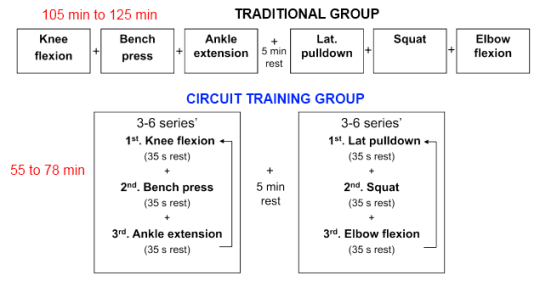Anatoly | Sun October 30, 2011
What do you think, Anoop? Less weight, Less time, almost same results. Does it looks little suspicious?

October 30 2011
Circuit weight training takes less time compared to traditional weight training, but can it increase strength and muscle similar to a traditional routine?

Circuit Training: This type of training involves lifting lighter loads with very short rest periods of time. The lifter moves from one exercise to the next in 15 -30 sec (or no rest) and completes a series of circuits. The weight is usually around 40-60% of 1Rm which equates to 10-20 reps.
Cardiovascular: There is a moderate Increase in cardiovascular capacity compared to traditional strength training.
Time: Less time is required since there is little or no rest in between sets.
Fat Loss: There maybe greater fat loss with circuit training compared to traditional training.
Strength & Muscle: Since the weights used are pretty light, the strength and muscle gains are minimal compared to traditional training.
Bone Mass: This is also true for bone mass since there is less loading.
Purpose: The purpose of the study was to study the effect circuit training with heavier loads ( 6 reps) on body fat, strength, muscle, cardiovascular response compared to a traditional routine.
Duration: 8 weeks
Participants: The subjects were trained men.
Rest between sets: The traditional group did the same number of exercises separated by 3 min rest while the circuit training group rest time was 35 sec.

Anatoly | Sun October 30, 2011
What do you think, Anoop? Less weight, Less time, almost same results. Does it looks little suspicious?
Anoop | Sun October 30, 2011
Hi Anatoly,
If you look at the program, it is not hard to go through with a short rest time.
You are going from leg extension to Bench press and then to ankle extensions. It would have made a big difference if they were doing the same exercise again with short rest. And there is only one major compound movement so the fatigue is not that great either.
In fact, I would have a hard time resting 3 min to do isolation exercises like ankle extensions and knee flexions.
Anatoly | Sun October 30, 2011
So exercise order do matters in this case.
If order were different the results might be different?
So, there are some smart program design by authors. Cheers.
near60lifter | Sun October 30, 2011
It may be interesting to note that a form of circuit training has been used in bodybuilding for many years. It is called “supersets”. Opposing body parts are trained with short rest cycles. Actions like the bench press supersetted with the row was/is a common practice. This style of training was made famous by bodybuilders like the “Blond Bomber”, Dave Draper.
Anatoly | Sun October 30, 2011
Yes, but super-sets usually was used in pre-context stage, and not for mass building
near60lifter | Mon October 31, 2011
In California, super-sets were a commonly used technique and utilized on a continuous basis. There would sometimes be a “bulk-up” period which would last for a month or so but this was more the exception than the rule. Bodybuilder’s like Draper I believe used super-sets on a continuous basis and still uses it as his main form of training.
Anatoly | Mon October 31, 2011
Draper as well as every elite bodybuilder in golden era was on drugs. So the question of use super-sets for natural builder were open.
Anatoly | Tue November 01, 2011
Anoop, how can be explained fat decreases in circuit training group simultaneously with muscle growth?
They were trained, so it’s not newbie effect…
Anoop | Tue November 01, 2011
Hi Anatoly,
In fact, both groups saw an increase in LBM and a decrease in body fat. Only in the circuit training group the body fat reduction was significant. And the starting body fat was around 20% which could have affected the results.
And I don’t superset, but I always do one exercise and then go to a next one which hits a different muscle. If I do rest, that is usually for the bigger movement like bench, squat and deadlift. When I did full body, I always rotated like a circuit to save time and to get some rest for the specific body part.
Andreas Dietzel | Tue November 01, 2011
“There was an a decrease in body fat and an increase in body fat in both groups.”
Wait, what?
Should the 2nd “body fat” be switched with “muscle mass” or something similar?
near60lifter | Tue November 01, 2011
Anatoly, you are probably correct for a large percentage of the West Coast bodybuilders though I don’t think Draper with his heart condition uses anabolics any longer.
Supersets have some possible good points and maybe not so good. One good point is the reduced time in general that workouts take to complete and some suggest that they get a better “pump” as well. But in contrast and in possible contradiction, if a strong local metabolic stimulus is desired to optimize muscle protein synthesis and other factors it is perhaps not advantageous to work separate body regions which has the potential to dilute the effect.
I have had correspondence with one of the researchers in blood flow restriction training. He in further contrast recommends performing a exercise that stimulates the larger muscles after the execution of exercises for smaller groups. There is a study he quotes, I will have to see if I can find it, where I believe muscle growth was enhanced in the upper arm when followed by thigh exercises. It was thought that the strong increase in GH following the lower limb exercise may have produced this effect but we also have studies that show systemic GH increases appear to have little effect on some of the parameters associated with muscle hypertrophy. I don’t think all the answers are in yet.
near60lifter | Wed November 02, 2011
I seemed to have had a senior moment. In my last response I posted about GH being a possible factor in the benefits of lower body/large muscle mass training aiding smaller muscle growth. I had seen this mentioned before by another author but in regards the study that I was talking about, GH was not significantly elevated but it appears the authors of the study,http://ukpmc.ac.uk/abstract/MED/18202577, believe there may be certain circulatory factors that effect hypertrophy. Sorry for the mistake.
Joe Cannon | Mon December 19, 2011
Thanks for writing this Anoop. I putting it in my newsletter this month that goes out to personal trainers. I appreciate all of your efforts to help people!
Joe
Anoop | Wed December 21, 2011
Hi Jose,
Thanks Joe as always! Hope you read the article ‘Is exercise a Magic Pill article’!
Ben Davis | Fri January 27, 2012
There seems to be widespread consensus to keep workouts under 60 minutes to reduce elevated cortisol levels. In this study, im surprised that having a workout (non-circuit) that runs twice as long as the “circuit” workout didn’t see more impact from this effect.
I’ve always done my full body days in a circuit/superset style just to be able to pack in a few more lifts and still keep my workout under 60 minutes.
Are there any other studies out there on supersets…or on elevated cortisol levels causing reduced growth?
Fat burning is greater in circuit training, because of the EPOC effect !
Anoop | Thu February 09, 2012
Hi Ben,
Thanks for the comment.
That is just a theory. There might other hormones that inhibit the effects of cortisol on muscle growth or the effect may be too little to even bother about.
Hi Bane,
I haven’t see any convincing evidence to show EPOC plays a big role. It plays a role, but the question is how big?
Anoop -
I was already convinced that circuit-training could produce roughly similar results, to conventional protocol, provided that resistance is challenging. And due to time constraints this is generally the only way I train. However, this is what really caught my eye:
“Both groups improved in aerobic and anaerobic tests.”
Question: is it really necessary to add a cardio component for “heart health” ?
And isn’t ‘cardio’ a bit of a misnomer in any case ? Doesn’t the term generally (wrongly) imply that there is an exercise protocol which serves to isolate the heart and lungs ?
Seems to me that, in a sense, it is the function of the heart and lungs to facilitate mechanical work. Therefore, whatever is good for the muscles out to be good for the heart and lungs.
AndroStack X | Mon December 17, 2018
Good day! Would you mind if I share your blog with my zynga group?
There’s a lot of folks that I think would really appreciate
your content. Please let me know. Cheers
Anoop | Wed December 19, 2018
Of course. I would mind if you don’t!!
Thank you for asking
© 2008 - 2024 | Exercise Biology. All rights reserved.